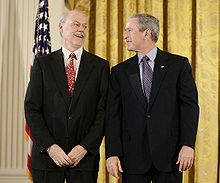Phillip Allen Sharp (born June 6, 1944) is an American geneticist and molecular biologist.
Phillip Sharp | |
|---|---|
 Phillip Sharp with George W. Bush National Medal of Science awards 2006. | |
| Born | June 6, 1944 |
| Nationality | American |
| Alma mater | University of Illinois at Urbana-Champaign |
| Spouse | Ann Holcombe |
| Awards | Nobel Prize in Physiology or Medicine (1993), National Medal of Science (2004) |
| Scientific career | |
| Fields | Biologist |
| Institutions | Caltech Cold Spring Harbor Laboratory MIT |
| Doctoral students | Andrew Fire |
He co-discovered gene splicing, and shared the 1993 Nobel Prize in Physiology or Medicine with Richard Roberts for "the discovery that genes in eukaryotes are not contiguous strings but contain introns, and that the splicing of pre-messenger RNA to delete those introns can occur in different ways, yielding different proteins from the same DNA sequence".
Sharp was born in Falmouth, Kentucky. He completed his PhD in chemistry at the University of Illinois at Urbana-Champaign in 1969. After completing his PhD he worked at the California Institute of Technology until 1971, where he studied plasmids and, later, gene expression in human cells at the Cold Spring Harbor Laboratory under James Watson.
In 1974 he was offered a position at MIT by biologist Salvador Luria. He was director of MIT's Center for Cancer Research (now the Koch Institute for Integrative Cancer Research) from 1985 to 1991; head of the Biology department from 1991 to 1999; and director of the McGovern Institute for Brain Research from 2000 to 2004.
Work
changeIt used to be thought that each gene on DNA coded for a single protein in a continuous strip. In 1997 Sharp and Roberts independently found out that genes were split into segments that were combined later in RNA processing.
Sharp and Roberts proved that the coding DNA is separated by stretches of DNA which are non-coding. The coding sections are exons, and the non-coding sections are introns.
Furthermore, it turned out that this structure occurs in all higher organisms. The discovery that a gene in could be present in the genetic material as several distinct and separate segments was revolutionary.
The second part of Sharp's work was in gene-splitting and gene splicing. This means to cut pieces out of, and add pieces to, a coding sequence. This creates a protein which works differently from the original version.
Suggested effect on evolution
changeThis kind of structure may allow more flexible responses to environmental change, and so speed up evolution. The structure may also be responsible for a number of inherited genetic defects.
Here's a key part of the Nobel presentation speech by Professor Bertil Daneholt of the Nobel Assembly of the Karolinska Institute:
- "Earlier it was believed that genes evolve mainly through the accumulation of small discrete changes in the genetic material. But their mosaic gene structure also permits higher organisms to restructure genes in another, more efficient way. This is because during the course of evolution, gene segments – the individual pieces of the mosaic – are regrouped in the genetic material, which creates new mosaic patterns and hence new genes. This reshuffling process presumably explains the rapid evolution of higher organisms".[1]
References
change